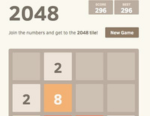What is the 2048 Game?
2048 is a single-player sliding puzzle game created by Gabriele Cirulli, an Italian web developer, in March 2014. Interestingly, the game was developed over a weekend and was initially just an experiment. It quickly went viral due to its simplicity, addictive nature, and fun challenge.
The game involves combining numbered tiles on a 4×4 grid to reach the tile with the number 2048. However, many players continue playing even after achieving that goal to reach even higher numbers.
How to Play 2048
The mechanics of 2048 are simple, yet the game can be surprisingly tricky. Here’s how it works:
- The Grid
The game board is a 4×4 square, consisting of 16 tiles.
- Starting the Game
The game begins with two tiles placed randomly on the grid. These tiles are usually numbered either 2 or 4.
- Making Moves
Players use arrow keys (or swipe gestures on mobile) to slide the tiles in one of four directions — up, down, left, or right.
- When you slide the tiles, all tiles move as far as possible in that direction.
- If two tiles of the same number collide during the move, they merge into one tile with the sum of the two values.
- For example, two tiles with a “2” will merge to form a “4”.
- Every time you make a move, a new tile (2 or 4) will randomly appear on an empty spot on the board.
- Objective
Your goal is to combine tiles until you create a tile with the number 2048. Once achieved, you can continue playing to see how far you can go.
- Game Over
The game ends when there are no more valid moves — i.e., the board is full and no adjacent tiles can be combined.
Why is 2048 So Addictive?
The charm of 2048 lies in its simplicity and the satisfaction of merging tiles. It offers:
- Quick gameplay: Each round lasts just a few minutes.
- Strategic thinking: It challenges your logic and foresight.
- Instant feedback: You immediately see the result of each move.
- Replayability: No two games are ever exactly the same.
It’s easy to pick up but difficult to master — the perfect recipe for a game that keeps pulling you back in.
Popular Versions and Clones
Since its release, 2048 has inspired countless clones, spinoffs, and variations, such as:
- 3D 2048
- 2048 Tetris
- Doge2048 (featuring the Doge meme)
- 2048 Multiplayer
- 4096 and 8192 versions for extended challenges
There are even thematic versions based on pop culture, including TV characters, emojis, and sports icons.
Winning Strategies and Tips
If you’re looking to improve your 2048 gameplay and increase your chances of reaching the 2048 tile (or beyond), here are some proven strategies:
- 1. Keep Your Largest Tile in a Corner
Pick a corner — usually the bottom-left or bottom-right — and try to keep your highest tile there. Build the other tiles around it in descending order. This gives your moves a consistent structure.
- 2. Don’t Move Randomly
Every move should have a purpose. Randomly swiping in all directions will quickly fill up the board and reduce your chances of making effective merges.
- 3. Avoid Moving Up (or the Direction Opposite Your Corner)
If you’re keeping your highest tile in the bottom-left corner, avoid moving up, as this can pull that tile out of place.
- 4. Plan Ahead
Look beyond just the next move. Think of how the tiles will react two or three moves in advance, especially when merging multiple tiles.
- 5. Build Chains
Try to place tiles so that you can make chain reactions, where one merge sets up another. This helps free up space and creates higher-value tiles efficiently.
- 6. Don’t Chase the 2048 Tile Too Hard
Focus on making clean, strategic moves rather than rushing to create 2048. The tile will come naturally as you build up the grid.
Common Mistakes to Avoid
- Filling up the grid too fast: This limits your movement options.
- Breaking your tile structure: Moving in a direction that displaces your high tile can disrupt your entire strategy.
- Ignoring small tiles: You need small tiles to merge up to big ones. Always leave room to spawn and grow them.
- Panic swiping: Reacting hastily often leads to dead ends.
Is There an End to 2048?
Technically, the game doesn’t end at 2048 — it continues until no more moves are possible. Skilled players have reached 4096, 8192, and even higher tiles like 16384 and 32768. However, these numbers require near-perfect play and a bit of luck.
The Math Behind 2048
2048 is essentially a game of powers of 2. Starting from 2, each tile doubles in value: 2, 4, 8, 16, 32, and so on. To reach the 2048 tile, you need to make 11 successful merges (2 → 4 → 8 → … → 2048).
Understanding the exponential growth can help you plan better. Each new level takes more moves, and the space required increases significantly.
Why It’s a Great Brain Exercise
Beyond entertainment, 2048 helps develop:
- Pattern recognition
- Strategic planning
- Mathematical intuition
- Spatial awareness
- Patience and focus
It’s like a workout for your brain — engaging without being frustrating.
Conclusion
2048 may look simple at first glance, but it’s a game of depth, logic, and strategy. Whether you’re killing time on your phone or trying to beat your high score on a computer, the satisfaction of merging your way to 2048 (and beyond) never gets old.
With a bit of practice, some patience, and the right strategies, anyone can become a 2048 pro. So next time you’re looking for a game that’s both fun and intellectually stimulating, give 2048 a try — and remember, every big tile starts with a single swipe.
Happy merging!

